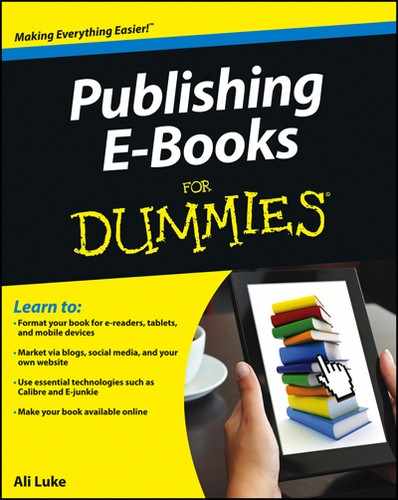Publishing Your E-Book on Different Platforms
The e-book market has grown rapidly over the past few years, which has brought a sometimes bewildering array of ways to sell your own e-book. You can sell copies of the same edition of a print book in multiple bookstore chains, but you’ll find that different stores and publishing platforms require differently formatted e-book files.
This section presents an overview of the ways in which you might want to sell your e-book. I cover all of them in more detail in Part IV of this book.
Hosting your e-book with E-junkie
One simple way to sell your e-book is to use a shopping cart site. It hosts your e-book file for you and, when a reader buys your book, delivers it automatically. You can choose among dozens of shopping cart sites and solutions, but I recommend E-junkie because it’s easy and inexpensive.
If you sell your e-book via E-junkie, you don’t even need a website of your own. You can reach potential readers on Facebook or Twitter or by e-mail and give them the link to buy your e-book.
Turn to Chapter 12 to find out more about using E-junkie.
Selling your e-book from your own website
Many authors choose to sell their e-books from their own websites. This option is helpful if you have a blog, because your readers are likely to become loyal customers. Selling your e-book from your own website also means that you keep all profits — no retailer takes a cut. You can also provide your e-book in any file format you want, and you can even package extras (such as MP3 recordings) with it.
In the online marketing world, a specialized e-book is commonly sold from a sales page. This type of page, which typically explains the scope of the e-book and the benefits of reading it, often includes testimonials from satisfied customers. If you’ve written an expensive e-book for a specialist audience, this is a useful way to sell it.
Turn to Chapter 9 to find out how to set up your own website. Chapter 10 explains how to create a sales page for your e-book.
Getting your e-book onto Amazon
Amazon, the largest retailer of e-books, actively encourages self-publishing authors to upload their own books in its Kindle Direct Publishing (KDP) program, and the process is relatively straightforward.
I don’t necessarily mean that Amazon is the perfect fit for you, though. If you write a specialized e-book with a small potential audience but a high retail price (more than $9.99), you’ll make much more money selling it from your own website, due to Amazon’s royalty structure and customer expectations. However, if you’re writing fiction or general nonfiction, you have nothing to lose by selling your e-book from Amazon.
Amazon pays 70 percent royalties on e-books priced between $2.99 and $9.99 and pays 35 percent royalties on e-books outside this price range. If you aren’t a citizen of the United States, your royalties are subject to withholding tax; if your country has a tax treaty with the United States (many do), you can fill in a form to ensure that this withholding tax isn’t applied to your royalties.
E-books sold via Amazon can be read only on the Amazon Kindle or on a device with the Kindle app installed. (You can find Kindle apps for the PC, Mac, iPad, and iPhone and for Android devices.) Kindle e-books cannot be read on the Kobo, NOOK, or Sony Reader.
Check out Chapter 8 to find out how to turn your manuscript into a MOBI file, which is the file format that Amazon uses. In Chapter 13, I explain how to upload your e-book file to Amazon.
Distributing your e-book to other stores via Smashwords
Of course, Amazon isn’t the only e-book store: Apple, Barnes & Noble, Kobo, and Sony all have online stores too. Every store has different, often complex, requirements. (Barnes & Noble requires you to have a U.S. bank account in order to collect royalties.) Rather than submit your e-book to every site individually, distribute it via Smashwords (www.smashwords.com
) to save time and effort.
Smashwords handles the file conversion, so you provide only a Microsoft Word document, formatted according to the site’s precise guidelines. You must also add Smashwords edition (or similar wording) to the copyright page; if you’re uncomfortable doing so, choose a different method of distribution.
Your e-book will be available via the Smashwords site for readers to buy in a number of different formats. Smashwords pays 85 percent royalties, minus a small transaction fee, for sales via its site, and it pays 60 percent of the retail price for most sales via other stores. For more on Smashwords, see Chapter 14.
